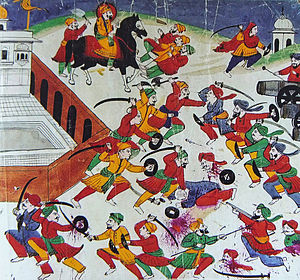Battle of Muktsar
| Battle of Muktsar | |||||||
|---|---|---|---|---|---|---|---|
| Part of Mughal-Sikh Wars | |||||||
 | |||||||
| |||||||
| Belligerents | |||||||
|
|
| ||||||
| Commanders and leaders | |||||||
|
|
| ||||||
| Strength | |||||||
| 7,000[4]– 12,000[5] |
40 mukte and Mata Bhag Kaur 1300 soldiers under Kapura Singh and Daan Singh | ||||||
| Casualties and losses | |||||||
| 3,000 killed[6] | 40 mukhte, 260 other soldiers[7] | ||||||
The Battle of Sri Muktsar Sahib (Muktsar) or Battle of Khidrāne Dee Dhāb took place on 29 December 1705,[8] (29 Poh) following the siege of Anandpur Sahib. In 1704, Anandpur Sahib was under an extended siege by the allied forces of the Mughals and the Hill States of Shivalik.[9]
History
[edit]During the siege 40 Sikhs, led by Maha Singh, wrote letters of bedava (abandonment of a Sikh from his Guru[10]) to Guru Gobind Singh ji. They arrived in the village of Jhabal where a Sikh woman named Mata Bhag Kaur, upon hearing their tale of desertion, motivated them into returning to Guru ji at Anandpur Sahib.
The 40 deserters with Mai Bhag Kaur returned to seek out Guru Gobind Singh ji, and joined him near Khidrāne Dee Dhāb preparing for battle against the Mughals. They fought the Mughals[11] and died in the following battle. The guru, finding the dying Maha Singh on the battlefield after the battle, forgave him and his compatriots, tore up their letters of bedava, and blessed them for their service.[12] The place was later renamed Muktsar, literally meaning The Pool of Liberation.[13][14] Mai Bhago survived the battle and stayed on with Guru Gobind Singh ji as one of his bodyguards. The Mela Maghi is held at the holy city of Sri Muktsar Sahib every year in memory of the forty Sikh martyrs.[15]
See also
[edit]References
[edit]- ^ http://sikhism.about.com/od/Historic-Events/p/Battle-Of-Muktsar.htm Archived 6 September 2015 at the Wayback Machine. commemoration varies with some marking the day on 15 April
- ^ Jacques, Tony (2007). Dictionary of Battles and Sieges: F-O. Bloomsbury Academic. p. 695. ISBN 978-0-313-33536-5.
- ^ Fenech, E. Louis; Mcleod, H. W. (11 June 2014). Historical Dictionary of Sikhism. Rowman & Littlefield. p. 65. ISBN 978-1-4422-3601-1.
- ^ Saggu, D. S. (7 June 2018). Battle Tactics And War Manoeuvres of the Sikhs. Notion Press. ISBN 978-1-64249-006-0.
In contrast Mughals were 7000.
- ^ Surjit Singh Gandhi (1978). History Of The Sikh Gurus - A Comprehensive Study. p. 451.
- ^ Kartar Singh (1951). Life Of Guru Gobind Singh. Lahore Book Shop. p. 253.
- ^ VSM, D. S. Saggu (7 June 2018). Battle Tactics And War Manoeuvres of the Sikhs. Notion Press. ISBN 978-1-64249-006-0.
over three hundred men were killed.
- ^ History of Sikh Gurus Retold: 1606-1708 C.E Surjit Singh Gandhi
- ^ Surinder Singh Johar (1998). Holy Sikh Shrines. M.D. Publications Pvt. Ltd. p. 46. ISBN 978-81-7533-073-3.
- ^ "Bedava". The Sikh Encyclopedia. 19 December 2000. Retrieved 24 September 2013.
- ^ Sagoo, Harbans (2001). Banda Singh Bahadur and Sikh Sovereignty. Deep & Deep Publications. ISBN 978-81-7629-300-6.
- ^ "Chali Muktay: The Forty Liberated Ones". Sikh Information. Retrieved 29 August 2014.
- ^ R. K. Pruthi (2004). Sikhism And Indian Civilization. Discovery Publishing House. p. 106. ISBN 978-81-7141-879-4.
- ^ Linda Edwards (2001). A brief guide to beliefs. Westminster John Knox Press. p. 171. ISBN 0-664-22259-5.
Battle of Muktsar.
- ^ Fenech, E. Louis; Mcleod, H. W. (11 June 2014). Historical Dictionary of Sikhism. Rowman & Littlefield. p. 65. ISBN 978-1-4422-3601-1.
